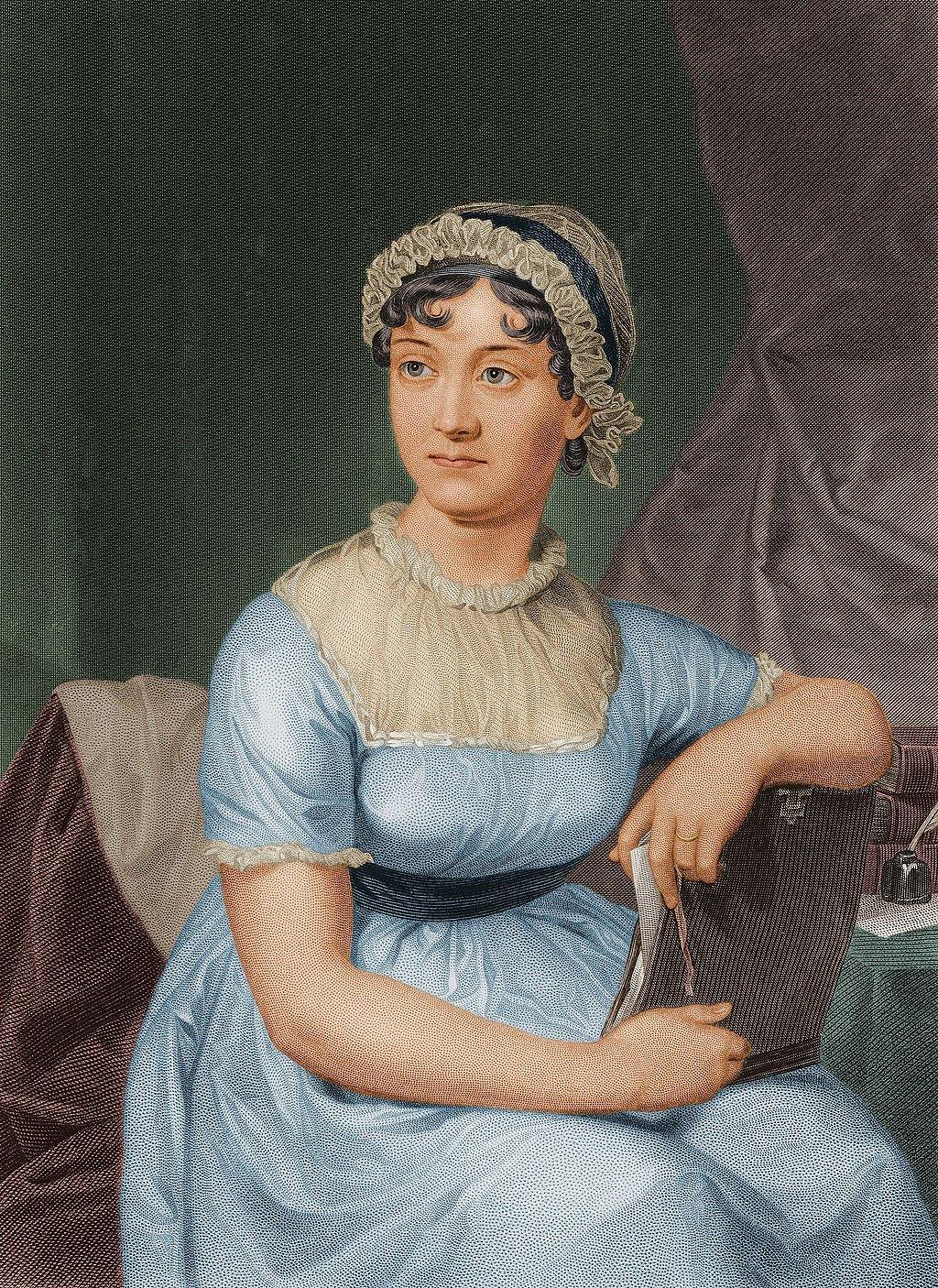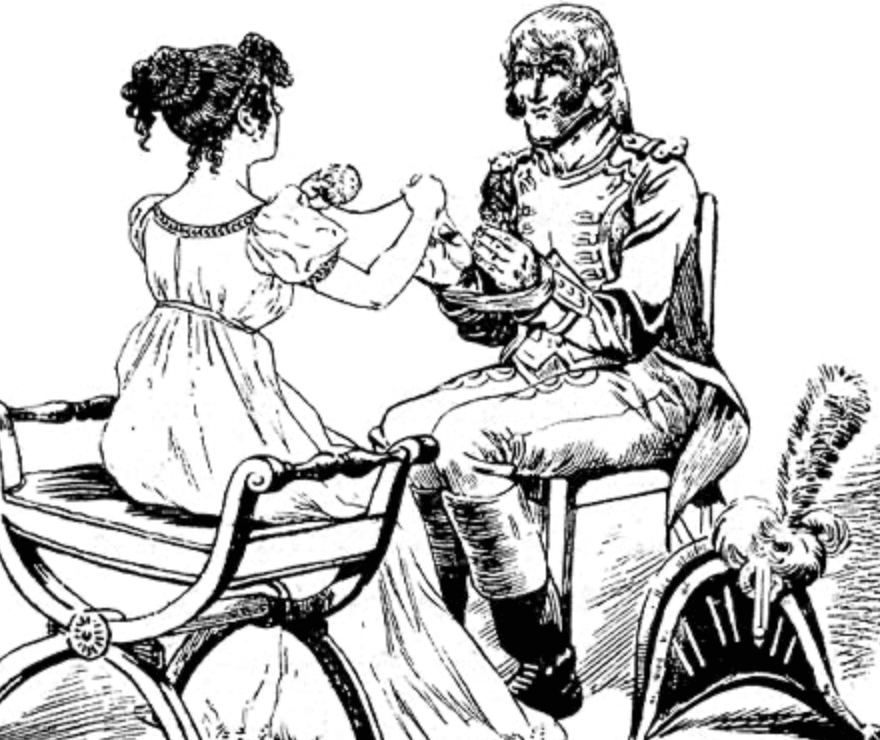Jane Austen and Vampyres
A mysterious plague has fallen up the quiet English village of Meryton—and the dead are returning to life! Feisty heroine Elizabeth Bennet is determined to wipe out the Zombie menace, but she’s soon distracted by the arrival of the haughty and arrogant Mr. Darcy. Wheat ensues is a delightful comedy of manners with plenty of civilized sparring between the two young lovers—and even more violent sparring on the blood-soaked battlefield. Can Elizabeth vanquish the spawn of Satan and overcome the social prejudices of the class-conscious landed gentry?
Complete with romance, heartbreak, swordfights, cannibalism, and thousands of rotting corpses, Pride and Prejudice and Zombies transforms a masterpiece of world literature…*  A friend of mine, author Diana Birchall, recently brought up the recent rash of Vampire novels, many with Austen references, asking if I could explain the sudden popularity of these trash sequels, e.g.,Pride & Predator and Pride and Prejudice and Zombies.
A friend of mine, author Diana Birchall, recently brought up the recent rash of Vampire novels, many with Austen references, asking if I could explain the sudden popularity of these trash sequels, e.g.,Pride & Predator and Pride and Prejudice and Zombies.
She wrote, “It seems to be an unstoppable genre, of unending fascination to young women particularly, and I’m baffled as to why. It would have had no appeal to me at all as a teenager. The teen vampire novels I’ve read are mostly very anodyne – toothless vampires, you might say. They usually drink blood, but in a nice way, if such a thing is possible. There’s nothing gruesome or gory about these books…Just dreamy young girl romance, and fantasy adventure…The dishy boy is a nice eligible vampire, that’s all, and he and the spunky girl save the world…I don’t get the appeal.”
It seems to me these books belong to the Harlequin kind. Another friend argued a while back that the recent film adaptations represent a Harlequinization of Austen’s novels. I’m not sure I agree with that, but I can see why someone could argue it. The key thing about them is that they are non-violent and make the vampire into a basically harmless suitor mindful of the welfare of the heroine. Pride and Prejudice and Zombies; Pride and Predator: the use of this specific title shows the desire to reach the huge audience which has been told that this novel is the greatest thing ever written outside Shakespeare (the sort of comparison one hears.) Literally 200% or more of people have heard of or read P&P over all her other novels. Lost in Austen was a P&P film sequel and P&P film adaptations & sequels far outnumber any other Austen adaptations.  When I taught on the gothic genre a few years ago, I ordered a volume of vampire tales (The Penguin Book of Vampire Tales).
When I taught on the gothic genre a few years ago, I ordered a volume of vampire tales (The Penguin Book of Vampire Tales).
These were not vapid and anondyne: they were brutal, and more than half frighteningly misogynistic. The vampires kill women and go after them with the same ferocity we see in Bram Stoker’s tale: men drive stakes into women, drain their blood; humiliate them. It was then, I learned, that the vampire tale differs from other horror/fiction subgenres precisely because it’s much more often written by men and filled with hatred and fear of women.
The comparison with, say, The Oxford Book of Ghost Stories is striking & instructive. Not brutal, often written by women (maybe more often), pro-women, with sympathetic heroines (like Mary Reilly), and heroes who are sensitive (nervous, like a Le Fanu or Oliphant) or very perceptive—-like M. R. James’, Edith Wharton’s and Henry James’ ghost stories. By contrast, now we have this new weak, non-violent, gentle kind of vampire story. All this overt worship of power, and (supposedly) physical freedom (which favors men as it makes women available to them in a culture where men have enormous power and far more money) produces a male genre which is emasculated so as to not to frighten or hurt the female reader who really does not want to engage in anything serious. 
This is not to say that all horror stories written by women are pushovers. Suzy McKee Charnas—remember her Vampire Tapestry— wrote an intelligent feminization of a vampire story in the 1980s, and I have a book from another once widely sold series, Chelsea Quinn Yarbro, where, again, the vampire is really a brutal creature—Yarbro presents women as masochistic. Valerie Martin’s Mary Reilly actually combines the brutality of the vampire-werewolf tale with the feminism of the ghost story terror of Ann Radcliffe. Martin’s remarkable short story “Sea Lovers” (originally titled “Spawning” in The Consolation of Nature) has brutal mermaid who casually murders a fisherman (reverse of old folk tale). So what we have are Harlequins with vampires, zombies and supernatural terrors hitherto part of genuine taboo-breaking horror stories.
The Twlight books selling wildly fit right here: inane Harlequinea, giving the girl a titillation of vampirism, but because she really is not masochistic and into violence, turning back to giving her a hero who will mother her. The word “Jane” in the title and suppose connection to Austen is the “clue” or sign that we are in popular harlequin land. We are really with cosy Jane still, only this time there are apparent vampires at the table drinking tea too.
Follies, whims, inconsistencies and nonsense do divert me, I own, and I laugh at them whenever I can.
Jane Austen
Some suggest the idea is to laugh at incongruity with disrupted Austen characters as vampires and zombies appear, for example, in Hugh Thomson illustrations. What an incongruous mix, indeed. It’s a trivializing very much in the spirit of the recent free adaptation of P&P, Lost in Austen. The mini-series begins with with a resonant reference to the anonymity and stress of modern life and the desire of the heroine to escape nightly by reading P&P. In the first two parts of the movie, there are thoughtful allusions to previous Austen movies, but as the changes in the story mount up, they become incoherent and silly, and by the end the series is filled with inconsistent absurdities, neither fantasy or realism. The ending undercut the serious charge of the opening by being in effect nonsense.
Follies, whims, inconsistencies and nonsense do divert me, I own, and I laugh at them whenever I can. Jane Austen
Some suggest the idea is to laugh at incongruity with disrupted Austen characters as vampires and zombies appear, for example, in Hugh Thomson illustrations. What an incongruous mix, indeed. It’s a trivializing very much in the spirit of the recent free adaptation of P&P,Lost in Austen. The mini-series begins with with a resonant reference to the anonymity and stress of modern life and the desire of the heroine to escape nightly by reading P&P. In the first two parts of the movie, there are thoughtful allusions to previous Austen movies, but as the changes in the story mount up, they become incoherent and silly, and by the end the series is filled with inconsistent absurdities, neither fantasy or realism. The ending undercut the serious charge of the opening by being in effect nonsense.
There are places in town, offices, where inquiry would soon produce something -- Offices for the sale -- not quite of human flesh -- but of human intellect…I did not mean, I was not thinking of the slave-trade…trade, I assure you, was all that I had in view; widely different certainly as to the guilt of those who carry it on; but as to the greater misery of the victims, I do not know where it lies. Jane Fairfax, Emma 
As a contrast, I have been listening to Anne Bronte’sAgnes Grey read aloud beautifully by Donada Peters: this story of a repressed governess has more genuine passionate emotion, brutality, vampirism (draining the life out of someone), more raw life (the young woman attempts to build a life for herself by succeeding in jobs where she is subject to an all-too-usual cruel humanity) than any of these thin vampire tales.
Ellen Moody, a Lecturer in English at George Mason University, has compiled the most accurate calendars for Jane Austen's work, to date. She has created timelines for each of the six novels and the three unfinished novel fragments. She is currently working on a book, The Austen Movies. This article first appeared as a post on her blog. Since then, many readers have left humorous and insightful comments about her theories. Click hereto read these, or leave one of your own. Jimandellen.org for further Austen related articles. *From the cover of Pride and Prejudice and Zombies Enjoyed this article? Browse our book shop



Leave a comment
This site is protected by hCaptcha and the hCaptcha Privacy Policy and Terms of Service apply.